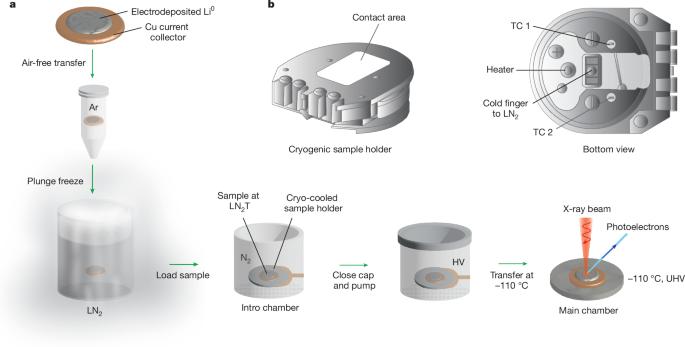Cryogenic X-ray photoelectron spectroscopy for battery interfaces
IF 48.5
1区 综合性期刊
Q1 MULTIDISCIPLINARY SCIENCES
引用次数: 0
Abstract
Understanding the chemical environment of pristine interfaces is a long-sought goal in electrochemistry, materials science and surface science. A substantial understanding of one such interface, the solid electrolyte interphase (SEI) in lithium anodes, originates from X-ray photoelectron spectroscopy (XPS)1,2. However, room temperature (RT) combined with ultrahigh vacuum (UHV) can induce major SEI evolution from reactions and volatilization during XPS1,2. Thus, a technique is necessary for SEI stabilization. Here we develop cryogenic (cryo)-XPS with immediate plunge freezing and demonstrate SEI preservation. We discover substantially different SEI speciation and a thicker pristine SEI with cryo-XPS, free from RT-associated thickness reduction and alterations to important species, including LiF and Li2O, in UHV. This new access to pristine SEI composition enables performance correlations across diverse electrolyte chemistries. Primarily, we highlight the necessity of studying sensitive interfaces under cryogenic conditions. Cryogenic X-ray photoelectron spectroscopy, combined with immediate plunge freezing, can be used to probe the pristine solid electrolyte interphase in lithium metal batteries.

电池界面的低温x射线光电子能谱
了解原始界面的化学环境是电化学、材料科学和表面科学长期追求的目标。对锂阳极中的固体电解质界面(SEI)的实质性理解源于x射线光电子能谱(XPS)1,2。然而,室温(RT)结合超高真空(UHV)可以诱导主要的SEI在XPS1,2过程中的反应和挥发。因此,一种技术对于SEI稳定是必要的。在这里,我们开发低温(冷冻)-XPS与立即暴跌冷冻和演示SEI保存。我们发现了实质上不同的SEI物种和更厚的原始SEI,没有rt相关的厚度减少和重要物种的改变,包括LiF和Li2O,在特高压中。这种对原始SEI成分的新访问使不同电解质化学之间的性能相关性成为可能。首先,我们强调了在低温条件下研究敏感界面的必要性。低温x射线光电子能谱,结合即时骤降冻结,可用于探测锂金属电池中原始固体电解质界面。
本文章由计算机程序翻译,如有差异,请以英文原文为准。
求助全文
约1分钟内获得全文
求助全文
来源期刊

Nature
综合性期刊-综合性期刊
CiteScore
90.00
自引率
1.20%
发文量
3652
审稿时长
3 months
期刊介绍:
Nature is a prestigious international journal that publishes peer-reviewed research in various scientific and technological fields. The selection of articles is based on criteria such as originality, importance, interdisciplinary relevance, timeliness, accessibility, elegance, and surprising conclusions. In addition to showcasing significant scientific advances, Nature delivers rapid, authoritative, insightful news, and interpretation of current and upcoming trends impacting science, scientists, and the broader public. The journal serves a dual purpose: firstly, to promptly share noteworthy scientific advances and foster discussions among scientists, and secondly, to ensure the swift dissemination of scientific results globally, emphasizing their significance for knowledge, culture, and daily life.
 求助内容:
求助内容: 应助结果提醒方式:
应助结果提醒方式:


